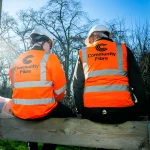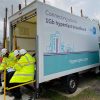AltNet Full Fibre ISPs Target 29.9 Million UK Premises by 2025

A new report from the Independent Networks Co-operative Association and Point Topic has estimated that alternative “full fibre” (FTTP/B) broadband ISPs grew their UK coverage by 110% in 2020 (up from 52% last year) and cover 2.586 million premises – such providers now aspire to cover 29.9m by the end of 2025.
The figures given above are lower than those stated in Ofcom’s latest Connected Nations 2020 report (here), which found that full fibre networks had passed over 5.1 million premises by September 2020 (18% of the UK). The difference stems from the fact that INCA’s data excludes Fibre-to-the-Premises (FTTP) deployments from major established operators – Openreach (BT) and Virgin Media – in order to focus on independent alternative networks (altnets) like B4RN, Cityfibre, Gigaclear, Hyperoptic, CommunityFibre, G.Network and many more (Summary of UK Full Fibre Builds).
As things stand, the report predicts that gigabit-capable altnet providers will deliver to 6.637 million premises by the end of 2021, before rising to 29.9 million by the end of 2025. But the figures for 2025 are based more on future deployment aspirations and so must be taken with a pinch of salt, particularly since unexpected events like COVID-19 can easily disrupt such plans.
Advertisement
Meanwhile, the current take-up rate is 32.67% (up from 30% last year), which is a good result as fibre operators tend to look for adoption of around 20-25%+ to help make their models viable. At this point we should caveat that take-up is something which grows slowly over time, and it’s often suppressed during the rapid ramping-up phase of a new network deployment (i.e. building far faster than people are able to adopt it).
One other caveat is that these figures aren’t weighted against the potential for overbuild with rival networks and are thus more of a raw overall total from all operators. Furthermore, there is often a tendency for some operators to report technically unfinished or non-live builds (i.e. you can’t yet order the service itself) in their premises passed figures, which can cause complications when forecasting coverage.

Meanwhile, Fixed Wireless Access (FWA) networks are estimated to cover over more than 2 million UK premises (roughly the same as the 2.3m figure they touted last year), although not all will have full service available (wireless signals are variable and so producing an accurate figure is extremely difficult).
Advertisement
Sadly, we don’t get a full split of the data for FWA connections this year and INCA’s forward forecast excludes them. “Unfortunately, there is still too little information available in the market for us to provide ro-bust future estimates for the fixed wireless sector,” said the report. But in their infographic it does mention gigabit-capable wireless services reaching 3 million+ premises by 2025 (up from 1m+ in 2021).
Finally, the study estimates that altnets have an intended capital expenditure (CAPEX) spend – from now until end-2025 – of over £10.8 billion, with operational expenditure of at least £1 billion. However, INCA warns that some of this may not be new money (i.e. re-announcements of existing funding) and some of those commitments may be quite aspirational, so it remains to be seen how much Capex actually occurs.
Malcolm Corbett, CEO at INCA, said:
“This report demonstrates that the ‘altnets’ are making a major contribution to meeting the Government’s targets for gigabit broadband connectivity. This current wave of investment, particularly in full fibre and wireless broadband networks, means there is no segment of the market where there isn’t a plan to build independent networks. This should be applauded and supported by government, regulator and the wider community.”
Altnet providers are clearly continuing to have an increasingly significant impact across the United Kingdom and that is set to continue for the foreseeable future, which is one of the reasons why major operators like Openreach have been ramping-up their own builds. Never underestimate what a bit of competitive pressure can do, as well as the usual changes via regulation (Ofcom) and a stronger political drive toward fibre.
Speaking of political drive, the Government’s new £5bn Project Gigabit scheme has of course promised to further boost such networks by supporting operators to deploy across the final 20% of predominantly rural premises, which often fall into the economically unviable trap (i.e. state subsidy is required to go further). The goal here is to make gigabit-capable networks available to at least 85% of UK premises by the end of 2025.
Advertisement
However, the increasingly aggressive level of competition within the market and future overbuild will perhaps inevitably produce both winners and losers, which tends to invite future consolidation as well as a few failures. Suffice to say that it’s always wise to take such forecasts with a pinch of salt.
Finally, it’s noted that altnet providers still have a number of familiar concerns, some of which (e.g. overbuild by Openreach), remain just as strong now as in previous years. Meanwhile other issues, such as the known problems with planning / street works delays and wayleaves (legal access agreements), have crept up the list of importance in 2021.
On the flip side, improvements to access via Openreach’s existing cable ducts (PIA) are clearly showing through.

Mark is a professional technology writer, IT consultant and computer engineer from Dorset (England), he also founded ISPreview in 1999 and enjoys analysing the latest telecoms and broadband developments. Find me on X (Twitter), Mastodon, Facebook, BlueSky, Threads.net and Linkedin.
« Tutela Study of UK 4G Mobile Broadband Speeds Ranks EE Top
Toshiba Extend Distance of UK Quantum Secured Fibre to 600km »






















































But how many premises will the 29.9 connections actually cover? i.e. is it 29.9 million premises with one Altnet each, or 10 million premises with 3 Altnets each?
With the overlap from recent announcements, I suspect closer to the latter.
This is of course the big unanswerable one, since we only have limited forward visibility of such plans and that makes predicting future overbuild extremely difficult.
The latter, of course. But it’s even worse than that I’m sure as some very densely populated areas will have even more than 3 and will greatly skew the figures even more. I would guess the REAL figures for actual, unique households that can access it will be considerably less.
It has been said so many times. Overbuild at the street level is a ridiculous thing. We don’t have multiple power cables or multiple water connections going down the street so why would you have multiple fibre? It’s completely the wrong way to do it and leads to a slow rollout that focusses all the resources on the most lucrative areas.
Water and Electricity are of course fairly linear utility supplies, where the product you receive as an end user isn’t much different from place to place (granted some exceptions for water quality there, but it’s a poor comparator). By comparison, broadband networks, quality and technologies vary a lot, so it’s not an equal comparison – data networks are very complex and can be very different.
However, many of these altnets are using existing cable ducts to run their fibre (e.g. PIA or concession agreements), so they don’t always need to dig up the same street multiple times.
I’m not sure I agree that data networks can’t be shared in the same way as other utilities. While the underlying technologies may vary at the lowest layer (ADSL/FTTC/FTTP/4G/FW/etc.) by the time you get to the transport layer it’s all starting to look rather similar.
And many ISPs have managed to sell differentiated products over the OR network for years, so I don’t really see that they now all have to have their own physical network.
Way back when there were competing electricity networks, Dave.
Only government can ensure no overbuild through legislation and something approaching nationalisation.
It wasn’t a big enough issue to tip the scales.
Regardless, some properties aren’t being reached by commercial deployments and will rely on taxpayer subsidy or non-profits.
Preventing altnets overbuilding won’t do anything for increasing coverage. They’ll all be forced to wholesale as people whinge when they don’t have options and offering a viable wholesale platform both costs and reduces revenue as no longer a vertically integrated business with revenues from end users.
Removing the requirement to wholesale most of their FTTP products from Telefonica and PT brought forward their builds considerably.
Lot of Cityfibre/VM overbuild.
Whilst I’m not complaining as choice is good, I have 3 FTTP providers to choose from where I live. 2 AltNets providing symmetrical gigabit for £50/month (+- £10) and OpenReach’s FTTP products.
The overbuild is real!
As is the underbuild in my sub-USO area.
I imagine both sets of build are proportional to the respective business cases.
£300-£500 per premises passed is doable in a number of urban areas. £1,200-£1,700 + taxpayer subsidy in some Gigaclear areas, and a bunch of those those went behind schedule and over budget.
It’s one thing putting the Fibre in the ground, or using Openreach PIA, but the success of these Altnets will depend on scale. Much of the hype focuses on the Fibre, but the Altnets need secure Head Ends, with all the associated plant and network Infrastructure, and the Engineering capability to maintain and monitor their network; Not cheap to run.
The Altnets will also have to compete with Openreach on the wholesale front, where Openreach’s scale allow operators like Sky cheap access to their infrastructure. This feels very much like the mid to late 90’s, when the Cable Tv companies failed. Many of these Altnets seem doomed to failure in my opinion.
Do they intend to long term succeed or is it a case of building up funding, paying a bunch of senior directors very well, then selling the company in 5 years for a pittance?
The cable TV companies were acquired for pretty handsome sums. Those that went bust did so due to build costs.
The bankruptcy protection ntl and Telewest went into was the result of debt accumulated buying up other companies.
You assume all these altnets will wholesale. Most won’t.
Consolidation is inevitable, as with cable. CityFibre and VMO2 will have their wallets open, indeed CF already acquired another altnet’s assets. The only real question is whether they’ll overpay per premises as massively as ntl and Telewest did in the 90s.
They won’t be hostile buyouts either. Funding is abundant, if returns remain as good as CF’s purchase of Fibre Nation gave it’s great business.
When I mentioned Wholesale, I wasn’t trying to suggest that all the Altnets would go wholesale, I was suggesting that companies like Sky could compete directly with the Altnets, as Openreach wholesale pricing is so competitive. As an example, I live in a Virgin Media Franchise area, but I’m on Sky and also receive my broadband from them over Openreach. My contract was recently up for renewal, so I renegotiated onto a new TV/Broadband contract for £42 a month, using BT’s new offerings as leverage. My Broadband, is Superfast over FTTC, but I could have gone for a TV/FTTP package for just £50 a month, had FTTP been available in my area. The Altnets are building into a highly competitive arena, where scale matters. CityFibre could mop up the assets of any failed Altnets, but they’d increase their debt and be faced with possibly large integration costs. It all feels like Deja Vu to me, and very reminiscent of C&W/Mercury mopping up the CTV companies in the 90’s, only to later sell them on to NTL, and look what happened to C&W eventually too. I vividly remember everyone prematurely writing BT off back then, similar to todays narrative.
It is mainly over build. A few exceptions of greenfield sites and developers tying the new homes into a single supplier without their knowledge.
As I’ve said before this is a ticking time bomb for the openreach network in that their model relies on the cheap to maintain, to off-set the expensive rural and legacy.
As the new busiensses only target high volume they are taking away massive market share.
I’ve no idea why this has not been highlighted or addressed at gov level.
The net contribution of unique new full fibre premises by alt nets is likely a very small number.
The quality is dubious too. I’ve seen a given alt net’s duct across road at 100mm.
I agree with above, we should have an entire nation with fttp now, at less cost and less disruption, with open access i.e. the Openreach model.